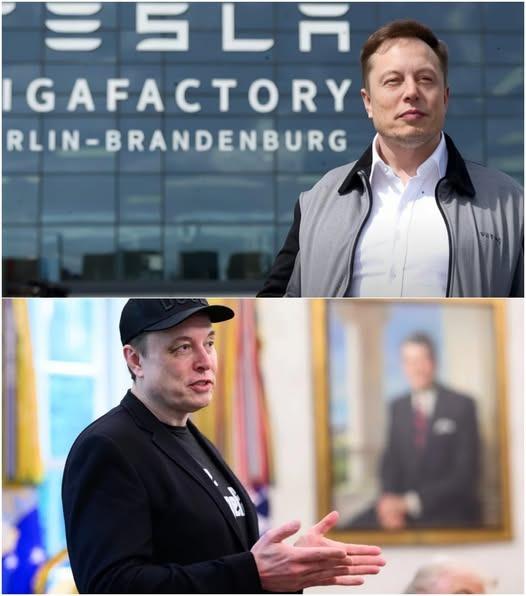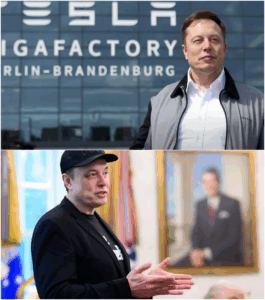Washington in Shock: Elon Musk’s Unexpected Public Move Goes Viral
If you’d told me a month ago that the most powerful man in the world would walk into my life and shatter everything I thought I knew about power, secrets, and purpose, I would have laughed in your face. But that was before the night I, Emily Carter—a tired, invisible government analyst and single mom—caught Elon Musk on a surveillance feed in Washington, D.C., doing something so secret that not even the government knew about it.

It was 11:03 p.m. on a rainy Thursday. I was working late again, eyes burning from hours of flagging anomalies in endless security footage, in a forgotten office behind Constitution Avenue. Most nights, my job was dull: tag drunks, pranksters, or the occasional lost tourist. But that night, a sleek black SUV rolled up to a restricted Department of Energy building. No plates. No diplomatic tags. Three figures emerged, two moving like trained operators. The third pulled down his hood, and my heart stopped.
Elon Musk. The walk, the jawline, the faint scar on his scalp. It was unmistakable.
But the system didn’t register his entry. No badge swipe, no facial recognition ping, nothing in the logs. It was as if the footage existed in a pocket of unacknowledged time. Instinct screamed at me to flag it, but I hesitated. Instead, I copied the video to a flash drive and stuffed it deep in my bag. I told myself I’d sleep on it, but deep down, I knew something was wrong. The moment I made that copy, my life split into a before and after.
The next morning, everything felt louder. My supervisor, Ted, asked if anything interesting came up. I lied, saying it was just raccoons fighting over a burrito. That afternoon, I called my old friend Danielle, a journalist in New York. “I have something big,” I whispered. She agreed to meet me that weekend.
But then I got a text from a blocked number: “Emily, stop.” No punctuation. No explanation. I hadn’t told anyone else. Someone was watching me. That night, a package arrived at my door—a burner phone, already charged, with a single video file. I played it, hands shaking.

Elon Musk looked into the lens, somewhere deep underground, fiber optic cables glowing behind him. “Not everything that’s hidden is dangerous, but some truths demand to be hidden a little longer. If you’re seeing this, it means you found one of those truths. And you’re not alone.” The screen went black.
Instead of threats, he sent understanding. A warning, maybe. But it changed something in me. The fear shifted to curiosity, then resolve. I started digging.
The building was owned by a Musk division called Helios Systems. Buried in network logs, I found massive data uploads at 3:14 a.m. every Thursday—petabytes routed through Starlink satellites to off-grid servers in Nevada. This wasn’t military. It was something new, something bigger than anything I’d ever seen.
I watched the footage again, frame by frame. Musk didn’t break in. He was expected—maybe he owned the place. What if the future wasn’t being built in Silicon Valley or the Pentagon, but here, in the shadows, by a man the world couldn’t decide whether to love or hate?
Days blurred. I became obsessed. I traced shell companies, patents for “magnetic confinement” and “stellar array control”—fusion terms. Nuclear fusion: the holy grail of clean energy. If Musk had built a working reactor, it would upend everything. No more fossil fuels, no more oil wars, no more centralized grids. It would destroy entire industries. The secrecy made sense.
But it also made me a target. Danielle cancelled our meeting abruptly, her voice on voicemail flat, almost robotic: “Don’t come looking for me. Walk away.” Then, a micro SD card arrived taped inside a newspaper on my stoop. It held a grainy video of Danielle, handcuffed, being led to a black SUV by men with military posture. She looked at the camera, not with fear, but defiance.
Now it was personal.
I started a journal on an offline laptop, recording everything. My son Jacob, ten years old, sensed something was wrong. “Are you spying on people now, Mom?” he asked one morning. I lied, said I was just tired. But I wasn’t tired—I was alive in a way I hadn’t been since college, when I believed stories could change the world.
One night, another message appeared on the burner phone: GPS coordinates in the woods outside D.C., and the words, “If you want the truth, come alone.” I packed a bag, kissed Jacob’s sleeping head, and wondered if he’d ever understand.
The woods were silent, thick with fog. At the coordinates, my phone buzzed: “Look up.” Above the trees, a silent, black shape hovered—no lights, no sound. A panel opened, and a staircase unfolded. I climbed, breathless, into a chamber pulsing with blue light.
Musk stood at the center, not smiling. “You brought the drive?” I handed it over, heart pounding.
“You weren’t supposed to see what you saw,” he said, “but maybe that’s not a bad thing.” He explained: the ship, the fusion reactor, Helios—it was all part of the same answer. “We’ve already tested a sustained reaction for twelve hours. No carbon output, no radiation leak. We’re standing inside the result.”
I stared at him, stunned. “Why tell me?”
“Because you didn’t run. You followed the thread. You’re not afraid of the truth. That makes you more useful than most agents I’ve hired.”
“I’m not working for you,” I shot back.
“I’m not asking you to. I’m offering a choice. Walk away, and your trail disappears. Or keep digging, expose this story, and become a threat to the system that profits from scarcity. Oil, control, fear—the world isn’t ready for what Helios can do. But maybe it’s time to make them ready.”
I hesitated. “I have a son. If I do this, he’ll be at risk.”
“That’s why I didn’t approach you sooner. But you want a better world for him. This is how it starts.”
I nodded. Then we began.
He introduced me to Dr. Adrien Singh, lead physicist on Helios. “This isn’t a crusade,” she warned. “It’s a precision operation. We’re not blowing whistles. We’re controlling the message. Can you handle that?”
I said yes. They gave me files, contacts, a new identity. My job: seed the truth, leak documents, spark questions, build public pressure—just enough to force transparency without chaos.
Back in D.C., I planted the first leaks—patent filings, redacted lab documents, rumors on tech forums. The chatter grew. Conspiracy theorists, engineers, even ex-government contractors started connecting the dots. The fuse was lit.
But Danielle was still missing. Using clues from the files, I found her held in a black site near Arlington. With help from an old hacker contact, I broke her out during a power shift, crawling through storm drains and dodging guards. She told me the truth: Helios was being used to gather behavioral data, mapped by foreign and domestic agencies. The tech was more than energy—it was surveillance, and Musk didn’t know.
We risked everything to warn him. With help from Macy, Musk’s secret protégé, we sent an encrypted message. Musk called us directly. “You’re right. I didn’t see it, but I do now. Meet me at Starbase, Texas. We finish this together.”
At Starbase, the fight escalated. Cyberattacks hammered our servers. Saboteurs tried to infiltrate the team. But the leaks kept coming, the story grew, and the public started demanding answers. Musk planned a live demonstration—Helios powering entire cities, emissions dropping to zero.
On the day of the broadcast, a blackout hit. Sabotage. But the team recovered, and the world saw the truth: clean, limitless energy was possible. Congressional hearings followed, and Musk testified with raw honesty: “The true threat to national security is secrecy without accountability. Transparency is the only safeguard.”
Opposition was fierce. Attacks, disinformation, even attempts to discredit us personally. But the movement grew. Communities formed energy cooperatives. Volunteers rallied worldwide. Musk opened dialogues with lawmakers and activists, pushing for ethical oversight and decentralized governance.
In the end, Helios became more than technology—it became a symbol of hope, trust, and the power of ordinary people to change the world. I watched Jacob run in the Texas sun, a lantern powered by Helios in his hand, his future brighter than I’d ever dreamed.
Cameras had caught what Elon Musk did in Washington. But what they didn’t catch was the spark that turned a secret into a movement, and a movement into a revolution.